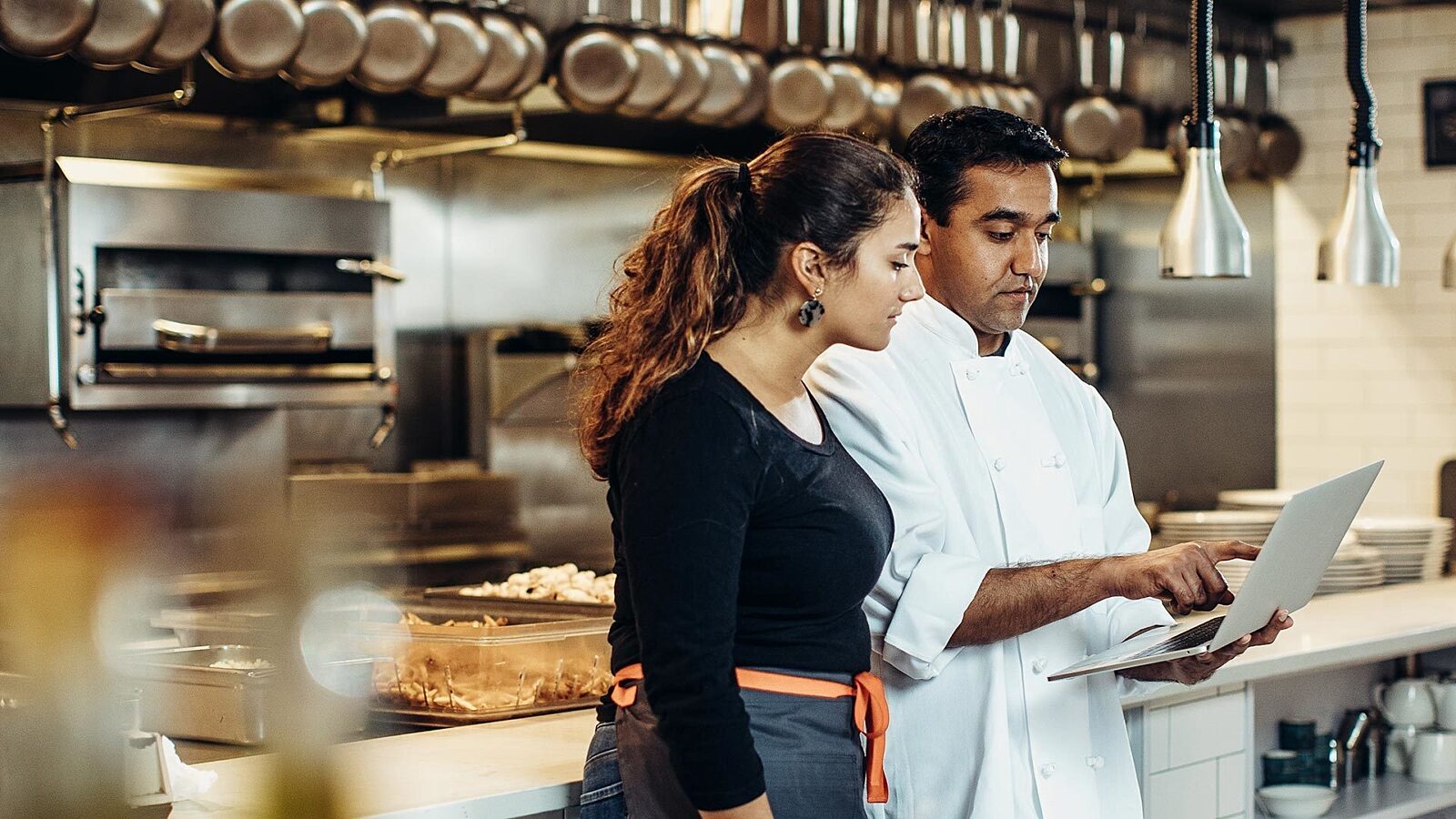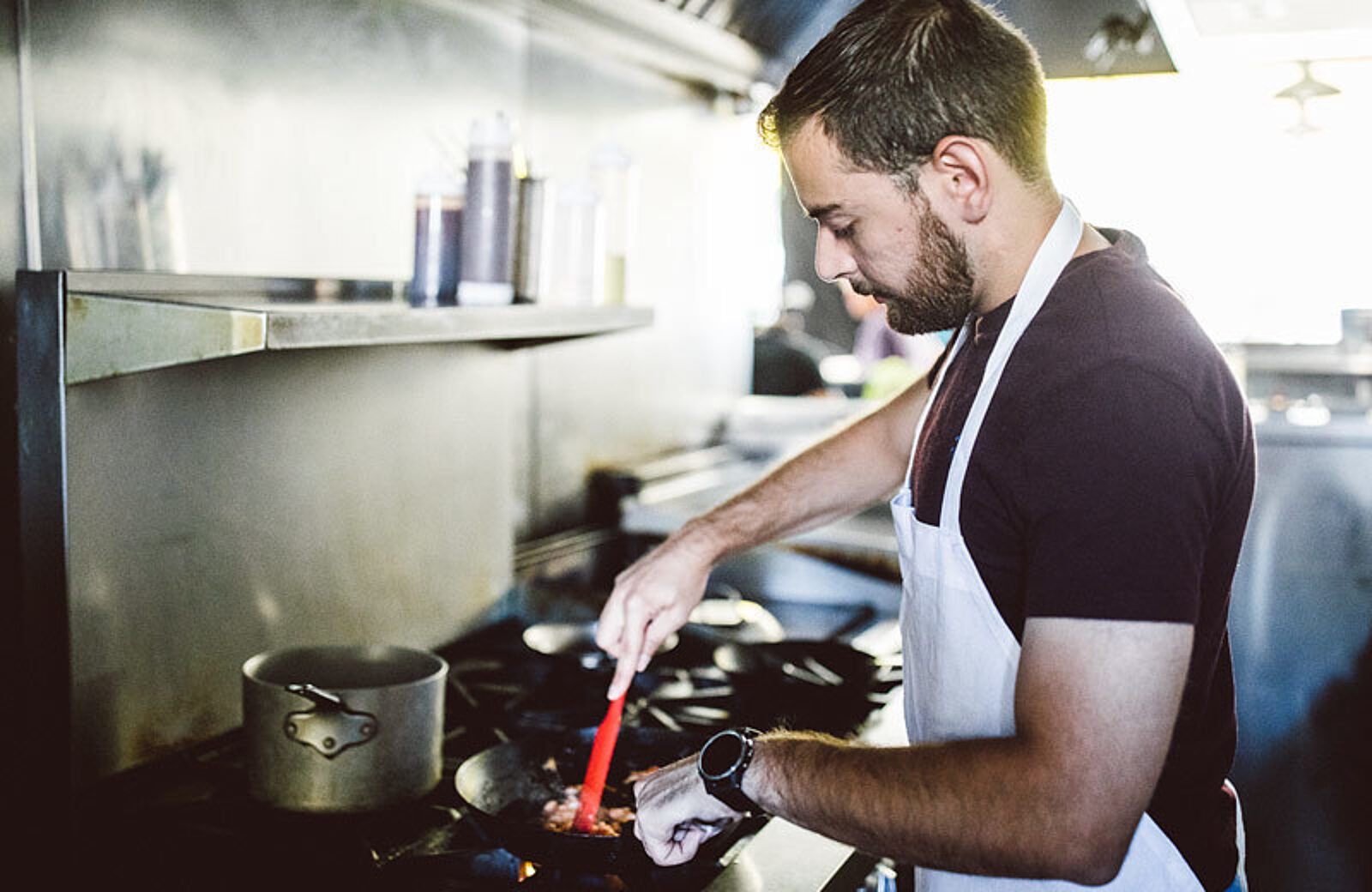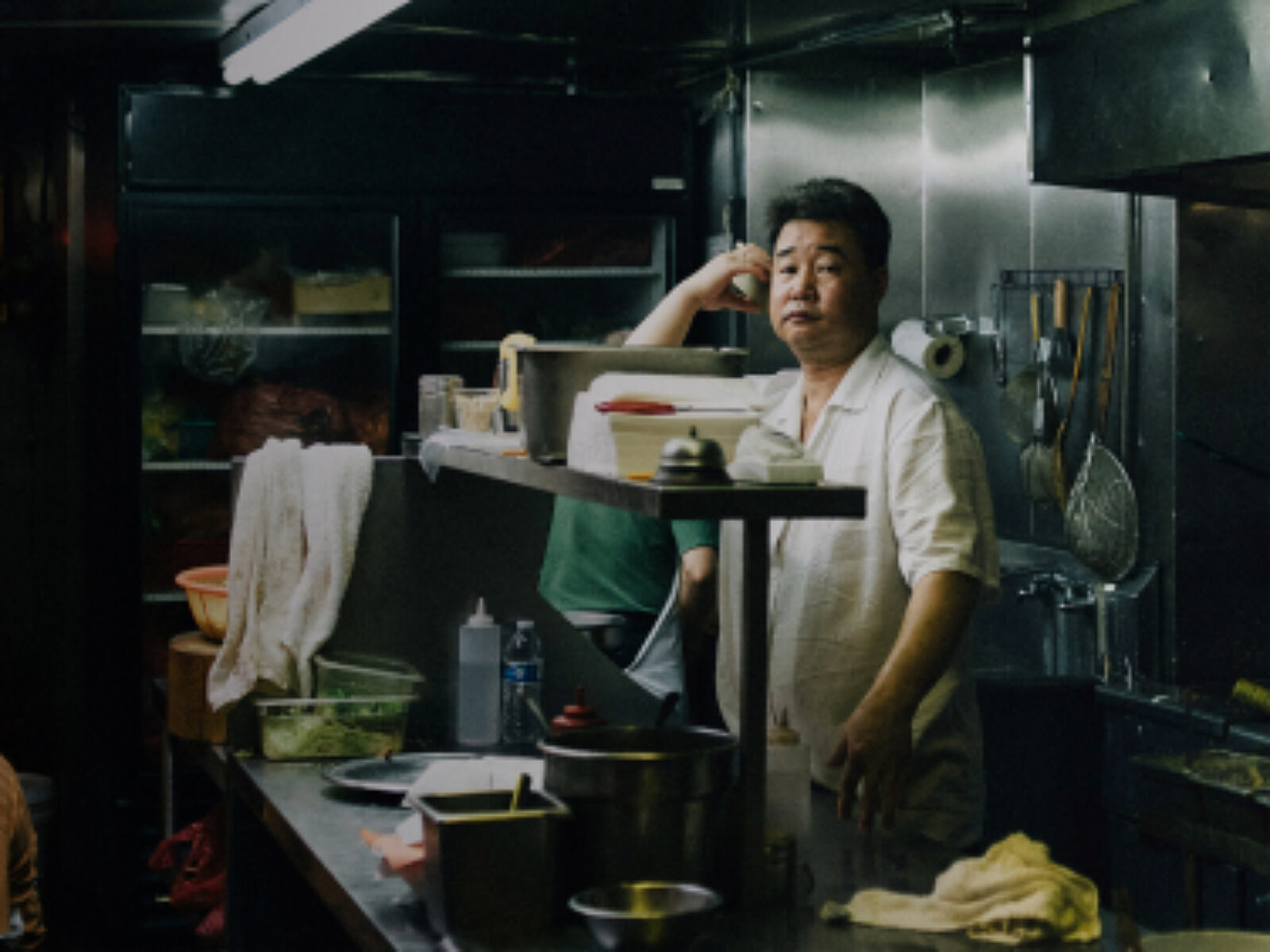
Select a Management Model That Benefits Your Staff
New staff management models, like profit-sharing and open-book management, could make your team a whole lot happier.

Tyler CumellaAuthor
Keeping restaurant staff happy is a bit of a balancing act. Your team has certain expectations about what work should look like in today’s employment landscape. And on the other hand, you need to convince your team that the restaurant industry is more than a revolving door. It can be a sustainable, legitimate career path if they want it to be.
There are a growing number of ways to manage, compensate, and reward restaurant teams. But the management model you choose affects your restaurant staff — and your ability to hire and retain them — in pretty significant ways.
Tip Pooling Calculator
Use the Tip Pooling Calculator to learn how to distribute tips back to your restaurant’s employees using the tip pooling method.

The old guard and the new wave
Traditional staff management models in restaurants have been in place for over a century. Don’t hierarchical employment structures and the tipping system feel as old as sliced bread?
In fact, tipping has been traced back to the 1800s, and it’s been noted for its troubling origins and history.
But as time has passed, and in the face of growing labor challenges, new staff management models have emerged in an effort to create sustainable workplaces for the people who dedicate their lives to this industry. These new approaches include:
- The gratuity-free model
- Employee profit-sharing
- Health insurance benefit offerings
- Safe and inclusive workplace management
- Mission-driven community advocacy
Emerging staff management models are still the exception rather than the rule, but some restaurant owners and operators are testing the waters. Here we’ll cover the definitions, benefits, challenges to getting started, and stories of restaurateurs’ first-hand experiences using these models.
The Gratuity-Free Model
What is the gratuity-free model?
The gratuity-free model — also sometimes referred to as the “tip-free” or “hospitality-included” model — is a system where servers don't accept tips and are instead paid an hourly living wage, often plus employee benefits like health insurance.
While exciting and revolutionary in its approach, the gratuity-free model is still in its experimental phase. According to this popular Reddit thread about the gratuity-free restaurant movement, there are currently 231 known restaurants in the United States employing a tip-free model. One of these restaurants is Juliet, in Somerville, MA.
Restaurateurs’ experiences with going gratuity-free.
Home to technically brilliant food, detailed wine and cocktail programs, and immersive, performance-like dinners, Juliet Somerville is an innovative restaurant in its community. Adding to this status is their use of forward-thinking compensation and management models.
According to Juliet’s media kit, “Prices at Juliet are inclusive of service; no gratuity is expected. Staff are paid a living wage above state minimums and participate in a profit-sharing program facilitated through the application of open-book management.” More on both profit-sharing and open-book management coming up in this story.
Katrina Jazayeri and Josh Lewin own Juliet, as well as the newly opened Peregrine. Josh told us, “Our reason for being a gratuity-free restaurant is rooted in our beliefs that minimum wage should be fair and that wages should be equitable across front-of-house and back-of-house staff. We have noted through research and anecdotal experience that standard tips and lower minimum wages in restaurants lead to higher degrees of sexual harassment and racial discrimination, alongside issues tied to immigration status. There’s a lot of discrimination when you have positions that can be paid very low wages and aren’t really earning tips, but, many times, people in these positions don’t have much of a voice in their own career development.”
Andrea Borgen, owner of Barcito, in Los Angeles, CA, is also a supporter of the “no-tip” movement. But her case is a complex one. She told us recently, “For the majority of our existence we had a hospitality-included, no-tipping model. We had implemented it about seven or eight months after opening. And we stuck with it until about early July, 2019.”
Following three years of being gratuity-free, Andrea switched Barcito back to a more traditional employee tipping model.
When starting her business, the gratuity-free approach addressed Andrea’s issues with tipping. She found it to be a more equitable solution to employee compensation and allowed her to take more responsibility for how they were paid. Adding to her own feelings on tipping, it was considered illegal to tip out the back of house in Los Angeles three years ago, when the minimum wage was lower. But things have since changed.
“It’s now legal to tip out the back of house,” she said. “As I started to run some projections and numbers and think about how going back to a traditional tipping model would impact my employees, it really seemed like the best possible solution for them in terms of how much money they would be making. I thought this move would do a better job of addressing that inequality than even the no-tipping model could. It reached a point where, even though I still don’t love the practice of tipping in general, I couldn’t shy away from what the numbers were telling me. At the end of the day, this was and continues to be about my employees.”
Whether you already own a restaurant or are planning on opening one, going gratuity-free takes real dedication and won’t be without its stops and starts.
Josh Lewin had this advice to share for restaurants considering going gratuity-free: “Look closely at why you want to be a gratuity-free restaurant. You need to really believe this stuff within yourself, and if this is not what you believe in, that’s fine. You need to seek out the strategies that allow you to fulfill your beliefs. You can’t make our goals your goals and expect to have our level of success because it's a huge commitment of time and spirit. Our lives are pretty much defined by this, so it can’t be an afterthought or you chasing an idea of the moment. Whatever model you decide on, it has to be something you really believe in.”
“Whatever model you decide on, it has to be something you really believe in.”

Josh Lewin
Proprietor and culinary director of Juliet Restaurant
Open-Book Management
What is open-book management?
Know the expression “like an open book?” Open-book management is a business concept that’s brought that saying to life.
Open-book management is a system where restaurant management shares the finances of the business with its employees. This lets employees see how their work contributes to revenue and helps them have a greater understanding of their business impact.
Henry Patterson is a senior partner at ReThink Restaurants, a consulting firm that provides strategic advising, training, and services to the restaurant and food service industry. They’re also a Toast partner. One of their missions is helping restaurants adopt open-book management.
“For me, open-book management is about creating a great place to work and a great company,” Henry told us. “Instead of having employees walk around and not know what's going on, you can actually include them in a really big way. Let’s put it this way: How do you have somebody play on a sports team and not let them know what the score is?”
Restaurateurs’ experiences with open-book management.
An open-book management model involves every staff member in the management of the restaurant to some degree, giving them a chance to have an active hand in running the business.
Doug Marschke, owner of Underdogs Too, The Taco Shop at Underdogs, and Tacko in San Francisco, CA, has seen a lot of success with open-book management at his restaurants. In particular, he’s seen the positive impact of open-book management on staff engagement and retention.
Doug told us, “[Open-book management] keeps everyone involved; everyone acts as a sort of owner. It made all the staff realize how hard the restaurant business is and how pennies really do matter. It also gives them insight into how much money I’m actually making. Our model requires us to be very busy in order to actually make anything, so people always assume that I must be a millionaire. But to see how much money and revenue we have to make in order to generate a small profit per month, I think it goes a long way in changing the mindset of our staff and gives me as an owner a little bit more credibility.”
Doug’s restaurants are rooted in a strong culture and values, so it’s hard for him to say that open-book management is the only reason they’ve seen great employee retention. But he believes the success comes from the powerful melding of culture, values, management, and compensation. He told us, “I think a lot of restaurant owners and managers are afraid of having that level of openness and honesty. People might get scared giving out all that information. But it really works out, good times and bad.”
While restaurants like Doug’s, and others including Juliet, Mei Mei, Paris Creperie, and The Rail Trail Flat Bread Co., have found success with an open-book management model, it’s not always a smooth road getting there.
Henry Patterson and the team at ReThink Restaurants have found, in their experience, that making the transition from a traditional management model to an open-book model takes at least eighteen months. It also requires deep dedication on the part of restaurant leadership. Patterson shared, “We’ve learned the hard way that, unless the leadership team is really committed to making this happen, it won't. The crises of the day will take over. People will do what they always do.”
Outside of the energy and time required of the leadership team, open-book management success is also impacted by employee hiring. You need to hire people who actually want to participate in this model along with you and your team. Say hello to accountability.
Henry had this piece of advice to offer employees joining an open-book management restaurant: “You're going to be part of an organization that isn't just doing today's job. You're going to be involved in project-based work and doing things that require longer-term involvement and commitment. You won’t just be doing your shifts and leaving.”
While not without its challenges, open-book management offers long-term benefits that are hide to deny — from increased job security to reduced cost of goods sold and higher rates of staff retention.
Employee Profit-Sharing
What’s employee profit-sharing?
Profit-sharing (also known as revenue-sharing) is an incentive-based system in which staff receive additional payment — alongside regular compensation and bonuses — depending on the restaurant’s profitability.
While not every restaurant that uses an open-book management model does profit-sharing, the two models often go hand-in-hand.
Restaurateurs’ experiences with profit-sharing.
Juliet Restaurant is an absolute pro at adopting many of the emerging staff management models, from profit-sharing to open-book management to gratuity-free.
Owner Josh Lewin told us, “Using open-book management and profit-sharing, we’re able to create incentives through alternative means. Everybody’s incentivized by the success of the restaurant because they play a direct role in it. The incentive in a traditional service environment is to sell as much as possible to each individual person because it’s literally your own money. What we're looking for is a more comprehensive view of what success looks like, what revenue growth looks like over time, and how our team can share the wealth.”
The Juliet team believes that profit-sharing and open-book management lead to a more unified staff, with everyone throwing their hats in the ring, together, in the name of better service, performance, and guest experience. It’s kind of beautiful.
Underdogs Restaurants is currently only doing profit-sharing for employees in manager-level positions, but owner Doug Marschke, seeing the model’s benefits, is figuring out how to do it for all employees.
He told us, “If we're not doing well or having a bad quarter, my employees know that it's going to have a financial impact on them. It inspires them to bring ideas that tie back to our open-book management model. It gets them thinking about things like ways we can save money on labor, reduce food waste, or new ways we can generate revenue. It’s amazing how many ideas will get spun out of all of that.”
Health Insurance Benefit Offerings
Is offering health insurance common in restaurants?
Currently, there are no federal or state laws mandating that small businesses in the restaurant industry provide health-related benefits — though the Affordable Care Act requires that all businesses with more than 50 employees offer some sort of health insurance plan.
Because of cost and sky-high employee turnover rates, it’s understandably hard for smaller restaurants to offer health insurance to their employees. But in the face of big, industry-wide staffing challenges, health insurance benefits are a highly valuable tool for both recruitment and employee retention.
Restaurateurs’ experiences with offering health insurance benefits.
Andrea Borgen, who we talked to above, provides health insurance to all full-time Barcito employees. She told us, “The turnover that you see at a place that offers more benefits versus one that offers basically nothing aside from what you can try and smash into your pocket by the end of the night is really significant. This is one of the tightest labor markets that we’ve ever seen, at least in the span of my career, and trying to attract and keep talent is really challenging. So you need to stack your deck with everything you can in order to be appealing and stand out.”
“This is one of the tightest labor markets that we’ve ever seen, at least in the span of my career, and trying to attract and keep talent is really challenging. So you need to stack your deck with everything you can in order to be appealing and stand out.”

Andrea Borgen
Owner of Barcito
Doug Marschke, who we also talked to above, is a believer in the retention power of benefits like health insurance. “Hiring and training a new person takes a lot of effort. It’s a big time and financial investment. It takes time to train new people, but it also takes time for new people to become good at their job. The first thirty days are a whirlwind, and they may not really be up to par with the rest of the staff until sixty days in. This is all a huge investment. If you have to keep doing this over and over again, you’re losing thousands of dollars. That’s why we spend the money upfront on benefits like health insurance to help us retain employees.”
According to respondents of the 2019 Restaurant Success Report, 31% of restaurant professionals provide health insurance to their staff. But there are blockers to providing health insurance and benefits.
One challenge is employee turnover, which has reached an annual rate of 74.9% according to the Bureau of Labor Statistics 2019 job openings and labor turnover survey. This challenge leaves restaurateurs at a tricky crossroads: If a restaurant employee is unlikely to stick around for more than a few months, and insurance waiting periods can take up to ninety days, is investing in employee health benefits really worth it? Some owners and managers don’t think so, citing a lack of regulatory requirements and poor restaurant profit margins as justification.
Another hurdle in offering health insurance to restaurant employees is cost. It’s no surprise to anyone that health insurance is expensive to provide in a low-margin business. One way restaurateurs are offsetting some of the cost of health insurance is through a surcharge on guest bills.
Doug told us, “Surcharges like these are pretty controversial, but they’re becoming more common. I know more restaurants are starting to do it. It's a few percentage points, like three and a half percent. But, honestly, that only covers one third of our bill. Because of our price point, we can't really raise our menu prices. We do tacos and burritos, not items that you can sell for $20. In a white tablecloth environment, I think you can hide a dollar or two into a menu item, and it won’t be a big deal. But for us to hide one or two dollars in a menu item would be a huge thing. So we do the surcharge and are very open with our customers about what it’s used for. It’s described on our menu and lets guests know that it only pays for a portion of the total cost of employee health insurance.”
Andrea doesn’t use this surcharge method and instead takes on the full cost of employee health insurance. It’s definitely a challenge, but she believes it’s worth the cost. “It's not easy, and it's very expensive, especially for a small independent restaurant like us,” she said. “But I definitely think that it pays for itself in terms of employee loyalty and fostering the culture that we want out of our workplace. We see the impact in turnover and labor costs, and all those things start to add up. You can also talk all you want about taking care of your employees, but if there are no tangible benefits to them working there versus the place across the street, I think it’s just lip service.”
If you’re interested in offering your restaurant staff health insurance and benefits but don’t know which HMO to choose, consider using a platform like Health Care HQ, Stride Health, or others that are designed for restaurants. They provide users with a comprehensive suite of health care insurance programs that they can pick and choose from, with plans for small restaurants, large restaurants, and individuals.
Safe and Inclusive Workplace Management
What are the strategies to creating a safe and inclusive workplace?
Inclusive hiring and harassment management are all about creating a safe, enjoyable place to work for people from all walks of life. Homeroom, a renowned restaurant in Oakland, CA that specializes in mac and cheese, has baked these two ideologies into its unique management model.
Why? Because for Homeroom co-founder and CEO Erin Wade, it wasn’t enough to just open a restaurant that served world-class mac and cheese. Erin needed to put specific strategies in place to protect her staff.
Homeroom’s experience with safe and inclusive workplace management.
Homeroom’s commitment to creating an inclusive restaurant environment starts with the hiring process. As Wade told us on The Garnish, “We seek out people with diverse life experiences. And I'm not talking just in terms of race or gender. We also work with organizations that place refugees, we hire people who are formerly incarcerated, and former foster youth. We're really looking to have a company that's as diverse as [Oakland, CA], the city that we live in, which is one of the most diverse cities in America.”
Once a new employee is hired, they’re given a two-hour cultural orientation, run by Wade herself, to emphasize the company’s commitment to inclusion and to teach it as a core value. Wade said, “We talk about it, and we train for it, and then we really try to live it. I mean, more than 70% of our leadership team are women and people of color. We just feel like that's really important. We work in an industry where, honestly, women and people of color comprise most of those who are in the lowest paid positions in the industry. But once you start going up that power ladder, you start seeing a lot less women, a lot less people of color. So we feel really committed to honestly just saying that that's important to us, so lots of different people raise their hands whenever we have leadership positions open up. We promote from within pretty much exclusively.”
Beyond actively promoting values like diversity, inclusivity, and empowerment, Homeroom has developed a much-lauded anti-harassment policy — one that Wade wrote about for an op-ed in The Washington Post.
After Erin started hearing stories from Homeroom’s servers about issues of harassment from customers, she gave her team the agency to develop an anti-harassment system themselves. They decided on a color-coded system in which different types of customer behavior are categorized as yellow, orange, or red.
- Yellow refers to a creepy vibe or unsavory look.
- Orange means comments with sexual undertones, such as certain compliments on a worker’s appearance.
- Red signals overtly sexual comments or touching.
During a shift, the affected staff member reports the color to their manager — they don’t have to explain what happened right away. Erin said, “In the case of a yellow or an orange, the manager just goes in and takes over the table. And in the case of a red, the manager goes in, takes over the table, and asks the guests to leave.”
It’s an approach that cuts off harassment at the source, blocking it from escalating. “What's been so amazing is that we came up with it as a way of dealing with the problem, but what it's actually done is really help curb the problem,” explained Wade.
Implementing the system has shown a marked reduction in incidents of harassment in the restaurant. “When we first held that meeting, sadly, every woman had a red story,” said Wade. “Now, they're happening maybe once a year. It's really uncommon. And it's a really elegant system ‘cause it's super easy to use. It's not complicated. You can use it on the floor of a busy restaurant. And, most importantly, it doesn't rely on managerial judgment of ‘is this harassment/is this not.’”
In September 2019, Wade adapted her anti-harassment program for restaurants across the country — she created an eye-catching restaurant safety poster and illustrated zine called Not on the Menu. Learn more about both here.
Mission-Driven Community Advocacy
What is mission-driven community advocacy?
A mission-driven approach, accompanied by a dedication to community advocacy, is a different spin on the newer wave of restaurant management models. Sidewall Pizza Company, which has four locations in South Carolina, is a shining example of this approach. Their staff’s response to the cause has been pretty powerful.
Sidewall Pizza Company’s experience with community advocacy.
Sidewall operates on a profit share model (not to be mixed up with profit-sharing). This means that every time a customer dines with them, a portion of the proceeds are dedicated to the Sidewall Pizza Community Fund. According to the restaurant’s website, “The Sidewall Pizza Community Fund is an ongoing fund from which we donate to individuals, families, and organizations in need in our area.”
Laura Smith is the Director of Community Engagement and Special Events at Sidewall Pizza, and she’s been with the company since May, 2018. She was brought on to focus on the restaurant’s community fund and donations, to help build relationships with the communities where they’re opening new restaurants, and to help develop partnerships with new non-profits and the schools in the area. She tells us, “We’re always doing things for people in the community, giving back, and donating stuff. If you pop into a Sidewall, everybody is always so happy and also happy to do anything to help their guests.”
Sidewall Pizza’s dedication to giving back to its communities has had a strong impact on customer relationships, but it also helps create a more positive work environment for its team. Laura tells us, “I think our community work helps everybody at Sidewall feel like they're part of a good team that is doing more than just making pizza. They're helping their communities.”
While not 100% quantifiable, Laura also believes that Sidewall’s mission-driven approach has had a positive impact on staff hiring and retention. She says, “This is my first restaurant-related job, but I'm always surprised to see how many people stay for as long as they do. You know, you think about the restaurant industry as a revolving door. People are always hopping from restaurant to restaurant. But there are a good number of people that have been here since Sidewall Pizza at Travelers Rest opened four years ago.”
Which Staff Management Model is Right?
Choosing a staff management model is a move that can change the course of your restaurant forever. Sounds dramatic, but their influence on staff hiring, engagement, and retention is undeniable. To even test into some of these approaches requires a ton of change.
Every restaurant is unique, so here’s a great place to start: Ask your team which model would make their lives any different or their connection to your business stronger.
What are your thoughts on these new management models? Are you already using one or several? Are you using a new model or approach not featured here? Tell us about it. Share your thoughts with us on Twitter.
To learn more about restaurant staffing and retention, check out Toast Video Courses.
Related Restaurant Operations Resources
Is this article helpful?
DISCLAIMER: This information is provided for general informational purposes only, and publication does not constitute an endorsement. Toast does not warrant the accuracy or completeness of any information, text, graphics, links, or other items contained within this content. Toast does not guarantee you will achieve any specific results if you follow any advice herein. It may be advisable for you to consult with a professional such as a lawyer, accountant, or business advisor for advice specific to your situation.
Read More
Subscribe to On the Line
Sign up to get industry intel, advice, tools, and honest takes from real people tackling their restaurants’ greatest challenges.





